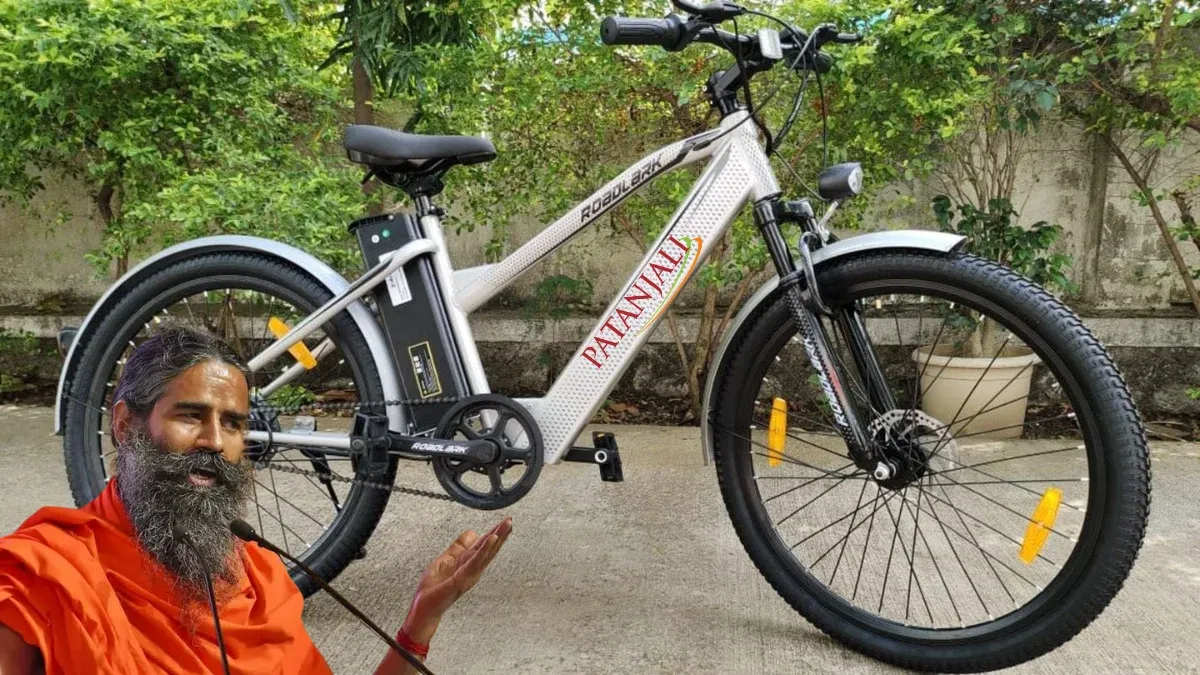Patanjali, under the leadership of Baba Ramdev and Acharya Balkrishna, is making waves in the electric mobility market with an affordable, innovative, and eco-friendly solution: the Patanjali Electric Cycle. This game-changing e-cycle, with its stunning price tag of just ₹5,000, promises to revolutionize both urban and rural transport across India.
Affordable, Eco-Friendly, and Revolutionary
With the rise of pollution and traffic congestion, affordable green mobility solutions are becoming more essential than ever. The Patanjali Electric Cycle is positioned to meet this demand by offering an electric mobility option that combines smart features, an impressive range, and an unbelievably low price point—making it accessible to all.
At its core, this e-cycle boasts a 250W brushless DC motor and a 36V 8.8Ah lithium-ion battery, offering a claimed range of up to 200KM on a single charge. While some users report a more conservative real-world range of 80-110KM, even this range puts the Patanjali Electric Cycle in a class of its own at this price.
Patanjali Electric Cycle at a Glance
| Feature | Details |
|---|---|
| Article Name | Patanjali Electric Cycle Review |
| Claimed Range | Up to 200 KM per charge |
| Launch Price | ₹5,000 (introductory) |
| Motor & Battery Setup | 250W BLDC motor, ~36V 8.8Ah lithium-ion battery |
| Government & EMI Options | EMI at ₹100/week, ₹1,000 trade-in discount |
| Commuter Economics | Running cost ~₹0.15/km |
| Official Website | www.patanjaliayurved.net |
Innovative Specs for Budget-Friendly Mobility
The Patanjali Electric Cycle is packed with features that push the boundaries of affordability while delivering practical performance. The 250W motor, paired with a lithium-ion battery, enables efficient energy usage. The cycle comes equipped with three riding modes—Eco, Standard, and Power—allowing riders to adjust their riding experience based on battery levels, terrain, and personal preference.
- Eco Mode: Ideal for longer commutes on flat terrain, offering a range of around 70-80KM.
- Standard Mode: Balanced mode for general use, delivering 50-60KM.
- Power Mode: For those who need a little extra zip, though range is reduced to around 35-45KM.
The cycle features an LCD display to track speed, battery levels, and mileage, alongside a USB charging port, making it incredibly practical for everyday use, particularly in rural or remote areas with limited electricity access.
Cost Structure
What really sets the Patanjali Electric Cycle apart is its affordability. At just ₹5,000 (with potential premium variants priced slightly higher), it’s priced far below most electric bikes and scooters on the market. The low price point is made possible by direct-to-consumer retail through Patanjali stores, local sourcing from Uttarakhand and UP, and the use of recycled battery cells from larger EV packs.
Even better, Patanjali is offering an EMI plan that starts at just ₹100/week, alongside an exchange discount of ₹1,000 for old bicycles. With an operating cost of just ₹0.15/km, the cycle is far more economical than other forms of transport, especially when compared to the costs of public transport or fuel for petrol bikes.
Real-World Range
The cycle’s advertised range of 200KM per charge is certainly eye-catching, but analysts suggest that this is likely an optimistic estimate. In real-world conditions, riders report ranges closer to 80-110KM, depending on the mode, terrain, and rider’s weight. While this is still impressive for the price, it’s crucial to set realistic expectations based on actual usage.
That said, the power management system that adjusts motor output based on terrain and rider input is a game-changer, allowing riders to optimize energy use and maximize range. Whether you’re cruising through the city or tackling tougher terrain, the Patanjali Electric Cycle adapts to your needs.
Practical Features & Design for Indian Roads
Weighing in at just 22 kg, the Patanjali Electric Cycle is light enough to be easily maneuvered on India’s busy streets. Its aluminum alloy or steel frame ensures durability without compromising on weight. For added convenience, the cycle features an adjustable seat and handlebars, making it comfortable for riders of all ages and sizes.
The cycle also includes dual disc brakes (or V-brakes in some variants), mudguards, and a rear carrier for added practicality. Its top speed is capped at 25 km/h, meaning there’s no need for a driver’s license or registration, making it accessible to a wide range of users—from students to delivery workers.
Who Will Benefit the Most?
The Patanjali Electric Cycle is particularly suited for:
- Students: Ideal for daily commutes of 15-30KM in small towns and rural areas.
- Delivery Workers: Cost-effective and efficient for gig economy riders looking for an affordable electric vehicle.
- Low-Income Families: Provides a budget-friendly alternative to motorized vehicles or public transport.
- Health-Conscious Individuals: With the ability to combine pedal power and electric assist, it’s great for those looking to stay active while commuting.
Even in its most modest configuration, the cycle offers greater flexibility, longer commutes, and reduced reliance on expensive fuel—all while promoting eco-friendly transportation.
The Patanjali Electric Cycle is a disruptive force in India’s electric mobility market. By combining a low price, practical features, and a reasonable range, it provides an accessible and eco-friendly transportation solution for millions. Whether you’re a student looking to cut down on daily travel expenses, a delivery worker in need of a cost-effective commute, or a health-conscious individual, this e-cycle is an affordable, sustainable, and practical choice.
If Patanjali can deliver on the real-world range and overall durability, this e-cycle has the potential to reshape the future of affordable electric mobility in India. It’s a bold step forward in making sustainable transport accessible to all.
FAQs
What is the claimed range of the Patanjali Electric Cycle?
Patanjali claims up to 200KM per charge, though real-world conditions suggest a practical range of 80-110KM.
How much does the electric cycle cost?
The introductory price is ₹5,000, with a potential premium for advanced variants.
How long does it take to charge the battery fully?
Charging takes between 4-6 hours, depending on the power source and battery level.
Do I need a license or registration?
No. The top speed is limited to ~25 km/h, which means no license or registration is required.
What are the operating costs per kilometre?
The operating cost is estimated at just ₹0.15/km, which is far lower than using petrol-powered vehicles or relying on public transport.




